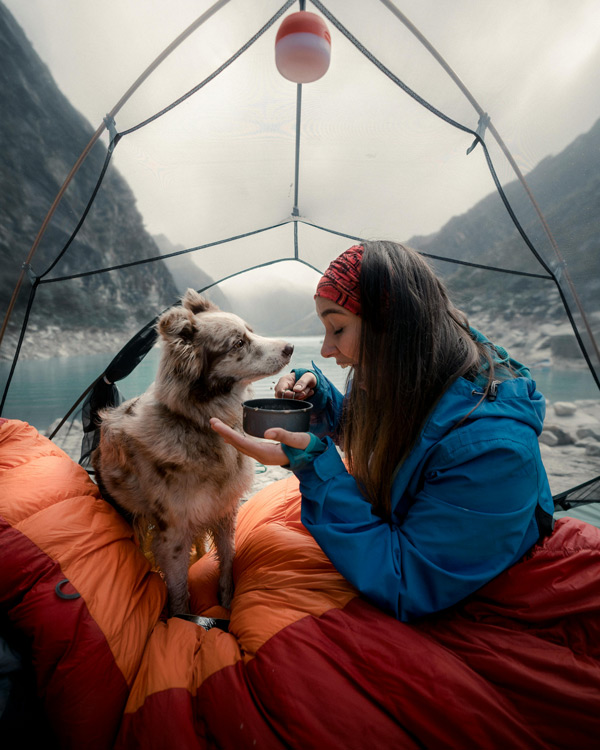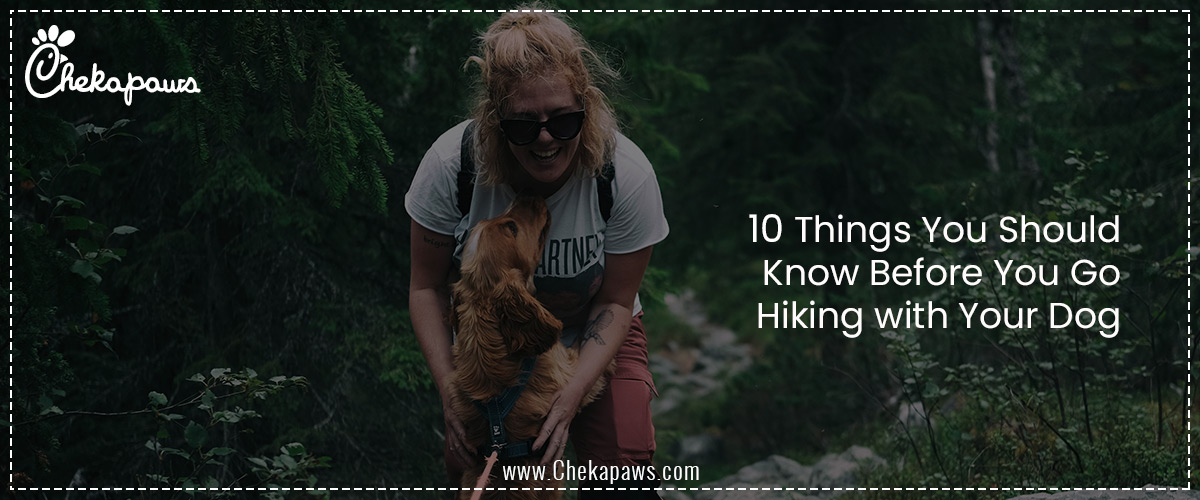As someone who is native to the mountains and has a pet, I agree that hiking is more than simply a terrific form of exercise, it allows you to reconnect with nature, breathe fresh air, and clear your thoughts. Imagine enjoying that experience with your dog, your most faithful adventure companion. Dogs like hiking just as much as we do, jumping across pathways and sniffing new surroundings. However, bringing your four-legged pal on a stroll is not as simple as grabbing a leash and heading into the woods.
There are numerous crucial considerations to consider before embarking on a path with your dog. A good walk with your dog needs careful planning and appropriate behavior, from recognizing your dog’s physical capacities to knowledge of trail etiquette and emergency preparedness.
This detailed guide will bring you through the 10 most important things to know before going hiking with your dog, ensuring a safe, enjoyable, and rewarding journey for both of you.
Table of Contents

Know Your Dog’s Fitness Level and Breed Limitations
As a pet parent, I am aware that not all pets are built for trekking, and those that are require time to develop stamina. One of the most common mistakes new dog hikers make is overestimating their pet’s stamina. Just because your dog can run around the backyard does not guarantee he can undertake a 10-mile mountain climb.
Assessing Fitness
Begin by taking shorter walks on nearby trails to check your dog’s energy levels. Are they enthusiastic and interested, or do they fall behind or exhibit indications of exhaustion? Look for signs such as heavy panting, limping, or disinterest. Dogs, particularly those with deep relationships with their humans, may push themselves too hard in order to stay up.
Breed Considerations
Being a pet parent I know some breeds are naturally more suited to trekking. Working dogs, such Siberian Huskies, Border Collies, and Labrador Retrievers, thrive in active outdoor situations. Brachycephalic (short-nosed) breeds, such as Bulldogs and Pugs, can have difficulty breathing during heavy activity or in warm temperatures.
Age and Health
Puppies and older dogs have different limits. Young puppies, particularly those under one year old, are still growing, and excessive exercise might injure their developing joints. Senior dogs, while eager to participate, may have arthritis or other health issues that limit their movement.
Before hitting the trail, consult with your veterinarian to decide whether your dog is healthy enough for hiking and what measures you should take.
Choose Dog-Friendly Trails
It’s not enough to know if your dog can walk you also need to know where they should go. Not all trails welcome dogs, and for those that do, the rules and terrain vary significantly.
Finding the Right Trail
Look for trails that are clearly dog-friendly. Websites such as All Trails and local park agencies frequently include filters for pet-friendly paths. Choose trails that are moderate in difficulty and have access to shade and water supplies, if available.
Understanding Regulations
Many paths require dogs to be leashed at all times, and some have specific restrictions on where they can travel. National parks in our country, for example, are famously tight regarding pet entry, frequently restricting dogs to parking areas or paved walkways exclusively.
Violating leash or access laws can result in fines—but more importantly, it might endanger your dog, wildlife, or other hikers.
Terrain awareness
If your dog is unfamiliar with sharp rocks, hot sand, or steep climbs, stay clear of such trails. When choosing a path, keep your dog’s comfort and safety in mind just as much as your own.
Train Your Dog for Trail Manners
Even the most laid-back trails may become chaotic if not handled properly. Dogs that bark continuously, lunge at other hikers, or chase wildlife are not only obnoxious, but also dangerous.
Obedience Basics
Your dog should constantly respond to simple orders such as:
- Come
- Sit
- Stay
- Leave it alone.
- Heel
Perhaps the most crucial is reliable recall. Will your dog return right away, regardless of the distraction, if they go off the leash?
Socialization Skills
Dogs should behave calmly and non-reactively around humans, other dogs, kids, and animals. Your dog might not be prepared for crowded trails if they have a tendency to growl or bark when frightened.
Trail Etiquette
Make way to other bikers, hikers, or horses at all times. When you pass other people, keep your dog close by. Let hikers who are more rapid move ahead. Even if you’re in the middle of nowhere, pick up your dog’s feces.
Trails are kept open and accessible for pet owners by well-behaved dogs.
Pack the Right Gear for Both of You
Gear is important for safety, comfort, and preparation when hiking with your dog it’s not just about convenience.
Must-Haves for Your Dog
- ID-tagged collar or harness (microchipping advised)
- Leash length: 4-6 feet (avoid retractable)
- Bowls for food and water that collapse
- Poop bags (as well as a way to pack them out)
- Booties for dogs (for hot or rugged terrain)
- Dog-safe sunscreen and insect repellent
- A portable first aid kit
- jacket or cooling vest (weather depending)
Optional but Helpful
- Dog backpack: Although it’s recommended to keep the weight of your dog’s backpack between 10 and 15 percent of their body weight, many dogs want to carry their own supplies.
- When your dog is off-leash in permitted places, a GPS tracker can be helpful.
- A cooling mat or towel is particularly useful for extended rest periods or cleaning up after a walk.
- Prepare your dog like you would yourself, considering all potential outcomes.
Hydration and Nutrition on the Trail
Dogs shed fluids more quickly than people do, particularly in hot weather or at high elevations. Offer water to your dog often rather than waiting for them to express signs of thirst.
Hydration Tips
- Bring extra water than you intend using.
- Water should be provided every 15 to 30 minutes during hot or demanding hikes.
- Show your dog how to use a water bottle with a spout or a collapse dish for drinking.
- Stay clear of lakes and streams where they can be exposed to dangerous bacteria or Giardia.
Trail Snacks
Trail-ready dog biscuits or high-protein treats may help with energy restoration. A big meal just before or during the walk should be avoided as this might cause bloat, particularly in breeds with deep chests.
Protect Against Ticks, Fleas, and Wildlife
There are many risks associated with the vast outdoors, including pests and unpredictable wildlife.
Tick and Flea Prevention
Before your hike:
- Put on a tick and flea repellent that your veterinarian has suggested.
- For extra protection, think about using a natural spray that doesn’t include DEET.
After the hike:
- Check for ticks thoroughly, paying particular attention to the feet, groin, armpits and ears.
- To get rid of allergens or vermin, give your dog a bath or use pet-safe wipes.
Wildlife Awareness
Skunks, porcupines, bears, and snakes can all be quite dangerous. Teach your dog not to chase animals and keep them on a leash. If you’re in a high-risk region, keep an air horn or bear bell with you.
Understand Weather and Trail Conditions
Not every time does Mother Nature cooperate. It may surprise you to learn how vulnerable dogs are to weather extremes.
Hot Weather Risks
Dogs don’t sweat the way humans do. To control their body temperature, they pant, although this isn’t always sufficient. Keep an eye out for heat exhaustion symptoms:
- Panting excessively
- Laziness
- Drooling
- Vomiting
Avoid afternoon treks. For breaks, bring cool water or even ice cubes and stay on sheltered trails.
Cold Weather Risks
Certain breeds are suited for snow, while others are not. Hypothermia symptoms include:
- Feeling cold
- Toughness
- Gums that are pale
- Slowness
If your dog becomes wet, always dry them off and use sweaters or dog coats for smaller or shorter-haired breeds.
Prepare for Emergencies
Although nobody wants to think about their dog getting hurt or getting lost while hiking, being prepared can make the difference between a small annoyance and a serious situation.
First Aid Kit for Dogs
- Included in your kit should be:
- Bandages and gauze
- The antiseptic wipes
- Tweezers intended for ticks
- Powdered styptic (for bleeding)
- Socks or booties (for paw injuries)
- List of emergency contacts (animal hospital, vet)
Emergency Protocols
- On your trekking path, be aware of the closest emergency veterinarian.
- In case your dog is unable to walk, practice carrying them.
- If you lose signal, have a map or an offline GPS with you.
Leave No Trace – With a Dog
Respecting the environment is a part of responsible hiking. Be careful of how you and your dog travel around the environment since you can have an impact on ecosystems and wildlife.
Dog Waste
Even when you’re in the woods, always pick up your dog’s waste. Feces can damage local vegetation, contaminate water, and spread disease. Pack a canine waste carrier or a container that can be sealed.
Environmental Respect
- To prevent damaging delicate plants or habitats, stay on pathways.
- Don’t let dogs dig or chase after animals.
- Your dog should not be allowed to swim in protected water sources.
- Hiking responsibly contributes to the trail’s preservation for future hikers and others.
Monitor Your Dog During and After the Hike
Your work is not over just because the walk is over. Dogs may experience injuries or delayed reactions that you were unaware of while on the route.
While Hiking
- Keep an eye out for slowing down, licking paws, or limping.
- Pay attention to their level of mental alertness and hydration.
- Look for burrs, wounds, or overheating on the paws.
After the Hike
- Do a full-body check for ticks, cuts, or sore spots.
- Use warm water or wipes to clean their paws.
- After a period of rest, serve water and a little meal.
- Give them a peaceful, cool area to rest.
Within 24 hours of trekking, contact your veterinarian if your dog exhibits any strange behavior, feels lethargic, or rejects food.
Conclusion
One of the best ways to spend time in nature with your dog is to go hiking with them. You both benefit from brain stimulation, exercise, and fresh air, but most of all, you create priceless memories together. However, it is your duty to ensure that your dog is healthy, safe, and behaved appropriately while on the route.
You can make every walk an exciting experience by being aware of your dog’s physical limitations, packing the proper equipment, picking suitable trails, and keeping up with health issues and trail etiquette.
So put on your boots, put your dog on a leash, and go exploring—but make sure you have more than just treats with you. Also, pack wisdom. Happy travels!







